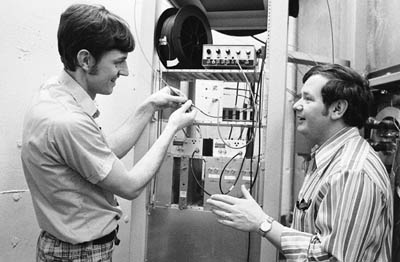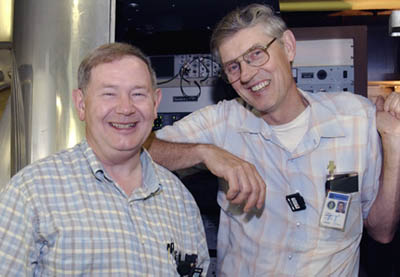 |
|
Still Buddies After All These Years by Sena Desai Ray Hren and Jim Wendt were hired on a cold, snowy January day in 1968 when Fermilab (then the nascent National Accelerator Laboratory) was a muddy field.
Hren and Wendt both received associate degrees in electrical engineering from Chicago's DeVry Institute. Both were in their early 20s when they joined Fermilab, among the first batch of technicians hired. They claimed ID numbers 80 and 81. They met in an orientation class on their first day on the job, instantly hitting it off. They share an office, love their work, and are always willing to offer help. "Our values and our outlook on life are the same," says Hren. Yet they count on the differences in their personalities and the contrasts in their skills and strengths. "We never compete with each other," says Wendt. "We have always recognized and used each other's abilities." Wendt—tall, lanky, quiet, a keen gardener—is a stickler for detail. "Wendt does everything so well, so perfectly. Even his garden is immaculate. Every weed is pulled out," says their supervisor, Elliott McCrory. Hren—shorter than Wendt, more gregarious, a devoted fisherman—has a fantastic memory. "He is on first-name basis with everyone in the laboratory," says McCrory. "When there is a problem, he knows exactly who can solve the problem and how." Hren's memory is legendary among laboratory technicians. If a technician wants to know how a problem was solved 20 years ago, he goes to Hren, who pulls out the exact page in the precise file in the right cabinet. Hren's resourceful memory and Wendt's attention to detail have combined on an array of challenges in their 35-year partnership. Soon after joining Fermilab, they were shipped off to Brookhaven National Laboratory on Long Island, New York to build coils for the linear accelerator's drift tubes. At Brookhaven, they spent their shifts building coils, and their spare time zipping around the countryside on Wendt's motorcycle. Six months later, the coils were done and the two had motorcycled to their hearts' content. They returned to Fermilab and assembled the linear accelerator in the old LINAC building, now the village machine shop. The accelerator was then a one-tank machine in a deep hole in the ground. Later, the accelerator was moved to the current Linac building. While Wendt built the coils for the 300 drift tubes in the nine accelerator tanks, Hren worked on the pre-accelerator, the Cockcroft- Walton. "They were both there with wrenches and calipers, helping build the accelerator," says McCrory. The linac was completed on November 30, 1970 and went into successful operation; when the lab decided eight years later to switch the initial stage of proton production from positive to negative ions, Hren and Wendt worked on the conversion.
Hren and Wendt are now senior operations specialists. "They both have very good commonsense ability," says applied physicist Chuck Schmidt, who has worked with them for 25 years. "They have a broad range of knowledge and experience. They are now working with a physicist on ideas to increase the beam's intensity. Their work is that of a specialist." Hren's and Wendt's main job—the names are always linked—is maintaining the proton source accelerators, which they accomplish with their complementary styles. Every two months, Wendt meticulously cleans and reassembles the ion source, which transforms the hydrogen gas into a beam. Hren took on more paperwork over the years—safety reports, the accelerator's operation reports, and ordering spares. They claim they have never had an argument while sharing a small office in the LINAC building, and no one disputes them. "It is almost like they know what the other one is thinking," says McCrory. "They are as easygoing as they come." Because they were cramped in their little office, sharing it with two other part-time employees and an assistant, McCrory decided to give Hren and Wendt two separate offices, side by side. But Hren and Wendt were not happy. With a wall between them, talking would be hard. So they found a solution. There is now a big window, about three feet by three feet, cut into the wall separating their new offices. |
| last modified 7/28/2003 email Fermilab |
FRLsDFx9eyfrPXgV
 Since then, they have watched that muddy field become the world's highest-energy
physics laboratory, and have seen their friendship strengthen while
working side by side in the Linac group every day for 35 years.
Since then, they have watched that muddy field become the world's highest-energy
physics laboratory, and have seen their friendship strengthen while
working side by side in the Linac group every day for 35 years.
 McCrory joined the LINAC group in 1986. In 1990
he began building trim magnets to steer the beam
and beam diagnostics to sense its behavior. He
drew on Hren's and Wendt's vast experience with
the accelerator. Together, they assembled the wire
scanners and trim magnets and built the beam
diagnostics.
McCrory joined the LINAC group in 1986. In 1990
he began building trim magnets to steer the beam
and beam diagnostics to sense its behavior. He
drew on Hren's and Wendt's vast experience with
the accelerator. Together, they assembled the wire
scanners and trim magnets and built the beam
diagnostics.